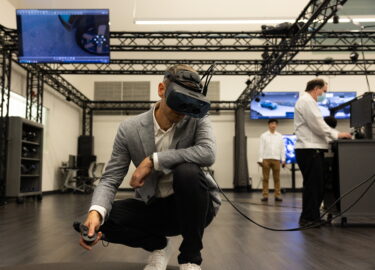Honda uses VR to design new cars

Honda wants to rely more on VR in car design: Some upcoming cars have already been developed without physical prototypes.
Virtual reality might establish itself as a stable element for 3D design and training in companies. Some companies have integrated immersive technologies into their workflows.
One vivid example is luxury carmaker Bugatti: The design process for new Bugatti cars could be shortened by a whole year thanks to VR, with savings amounting to around 440,000 euros, according to Bugatti.
The pandemic was a driving force for remote innovation at Honda
Honda has also been working with virtual reality for some time. At a press event, the Japanese automaker showed how the immersive technology is being used within the company.
"You can mature a design in a much shorter time frame," said a Honda representative at a meeting with selected press representatives. Using high-end headsets from Varjo (see our review of the Varjo XR-3), journalists were able to try out various demos that showed the results of different VR designs.
The vehicle design workflow involves replacing full-size clay models with a virtual vehicle in VR. To this end, Honda 2020 has opened two VR studios, one in Tokyo and one in Torrance, California. Unlike Bugatti, which integrated immersive technologies into its workflows early on, Honda's innovation was driven by the Corona pandemic.
Thanks to VR headsets, designers have had to travel less and have instead been able to work together on prototypes remotely via VR. The first results of this work are currently rolling off the production line, such as the Honda Prologue 2024 electric car and the Honda Pilot TrailSport 2023.
Honda increases efficiency through VR design
Honda spoke primarily about the efficiencies that the new design process brings, such as time savings from faster iterations, less waste and less environmentally damaging travel.
But there are not only positive aspects. Some employees don't seem to find it easy to leave their traditional habits behind. Especially in the vehicle interior, haptics is an important factor that makes the switch to VR a challenge for the designers, reports an employee of the car manufacturer.
Still, the benefits seem to outweigh the drawbacks. "Virtual reality prototyping removed limitations to the interior design and allowed us to address feedback quicker and collaborate more cohesively with the HMI and color, materials and finishes design teams," said Lisa Lee, interior design project lead.
"We don't want to lose emotion and the human touch to Honda design, so we won't pursue a purely digital approach, but we are really excited about the Honda products that will be coming to customers in the future by leveraging VR technology," said Mathieu Geslin, head of VR technology at Honda Design Studios. They plan to continue exploring the technical possibilities of VR and AR at their development centers around the world to further enhance the appeal and quality of their products.
Note: Links to online stores in articles can be so-called affiliate links. If you buy through this link, MIXED receives a commission from the provider. For you the price does not change.